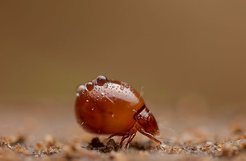Slug shuttle-service for mites

Oribatid mite of the Euphthiracaridae family. These mites travel alive in the gut of slugs. (Picture: Andy Murray)
On the menu for slugs are not only mosses, lichens and garden vegetables, but also miniscule oribatid mites, which they unavoidably take in with their food. Astonishingly, most of these tiny arachnids survive the voyage through the slug's digestive system without harm and are excreted, alive, elsewhere in the ecosystem. Scientists led by Dr Manfred Türke of iDiv research centre and Leipzig University have, for the first time, discovered this dispersal strategy, used predominantly by plants and known in the scientific community as endozoochory (dispersal by ingestion), also being used by mites. The researchers have published their findings in the journal Oecologia.
Animals and plants have, over the course of evolution, developed numerous strategies for colonising new habitats. For example, in summer, cherries are happily eaten by blackbirds. The birds excrete the undigested cherry stones in a different location where the plant can then germinate. Until now, little has been known about the dispersal strategies of soil organisms such as mites, nematodes and other invertebrates. They are extremely small and correspondingly slow but live in almost all soils, where they are critical to the functioning of the ecosystem because they break down organic waste and maintain nutrient cycles in the soil.
This makes the research results of the scientists led by Manfred Türke all the more important. For months, Türke collected Spanish slugs (Arion vulgaris) in the Leipzig riparian forest with the purpose of examining their excrement under a microscope. When he did this, the scientist made an astounding discovery: in the snails’ excrement, he found 36 widely distributed species of tiny oribatid mites (Oribatida). These arachnids inhabit the soil and the leaf litter of the forests and are not even a millimetre long.
Astonishingly, 70 percent of the mites eaten had survived passage through the snail's gut. In the laboratory, Manfred Türke observed that the mites can reach a new location, alive, by being transported in a snail's gut. This dispersal strategy is known in the scientific community as endozoochory (dispersal by ingestion) and has been observed very rarely in animals. For the mites, which are not only tiny, but also extremely sluggish and ponderous, the snails are therefore a means of transport and dispersal. Even the fastest mite can cover a maximum of two centimetres a day, while a large slug easily manages a distance of up to 15 metres a day. “This means about a thousand times the speed. When a snail creeps by, for a mite, it’s as if an ICE were thundering past,” says Manfred Türke. A train which many mites jump on. The biologist even suggests that a mite could be intentionally eaten: “It would be possible for the mite to notice when a snail is nearby and then crawl higher up in the vegetation in order to be eaten ... inside the snail, the mite would also be protected from predators.”
In addition to oribatid mites, the scientists also found plant seeds, mosses and, in particular, other living soil animals in the feces of the collected slugs. Therefore, it is likely that whole micro-ecosystems disperse using snails. This mechanism of dispersal could explain why minuscule soil dwellers, who can travel only a few centimetres a day, can colonise new habitats in an ecosystem with astonishing speed. A single square metre of soil can be home to hundreds of thousands of invertebrates and hundreds or even thousands of different species. A better understanding of these complex communities is crucial for preserving key soil functions such as carbon sequestration, drinking water purification and soil fertility.
Original publication
Gut shuttle service: endozoochory of dispersal-limited soil fauna by gastropods
Türke, M., Lange, M. & Eisenhauer, N. Oecologia (2018) 186: 655.
Contact at MPI-BGC:
Dr. Markus Lange
Phone +49 0()3641 57-6168
E-Mail: mlange@bgc-jena.mpg.de
